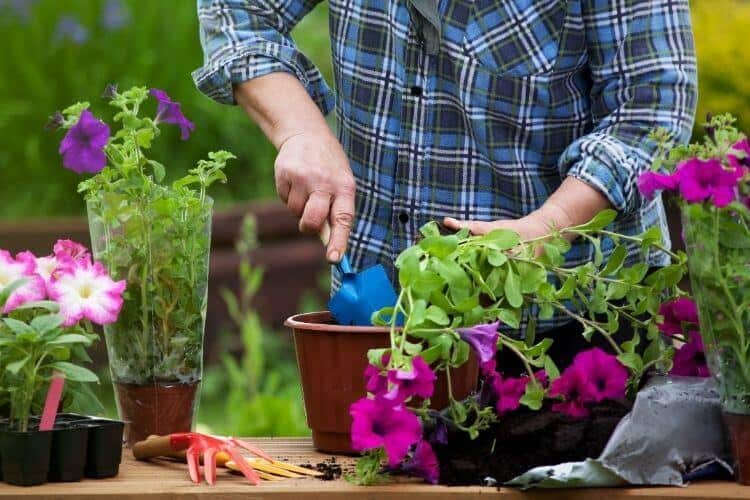I have been thinking of planting a section of my garden with flowers that can survive in partial shade and full sunlight. The flower which came into my mind is Petunias. I had thoughts that if they could grow in the shade since a large part of my garden is too shady, then my garden would look beautiful.
I did some research and came up with the following findings.
So, do petunias grow in the shade? Petunias can grow in partial shade conditions but thrive well in full sun. Petunias require at least half of the day’s sun to bloom and flourish. They grow best in well-drained soil. If petunias do not have access to enough sunlight, they will suffer from poor blooming, Yellow leaves, or even leggy plants.
Although Petunias can grow in partial sun and shade, the best place to grow them is in full sun. Plant them in areas that receive direct sunlight to produce tons of gorgeous blooms in any color. If they grow in areas with inadequate sunlight, they may fail to bloom. If you choose to plant them in more shade, be prepared for less production of flowers.
Petunias are among the easiest plants to grow. Their flowers are available in different colors. They are bright and lively, blooming from spring until frost.
Table of Contents
How Many Varieties of Petunias Are There?
There’s a lot of attributes about petunias, beautiful and lively annual that bloom dependably. These beautiful flowers also bloom in a range of colors and sizes, among other things. There are hundreds of petunias which fall into different categories based on growth habit and size. Read on to find out different varieties of Petunias.
Varieties of Petunias
Grandiflora Petunias
Grandiflora Petunias are the oldest types of petunias developed in the 1950s. They have several varieties measuring up to 12cm and spindle in summer. They have the largest flowers and perform best in moderate summer with less moisture. Their series include:
- Dream
- Ultra
- Storm
- Daddy
- Supercascade
- Super magic
Multiflora Petunias
They are small in size and bloom in small sizes. Multiflora petunia varieties do well in windy conditions due to the presence of a strong stem. Their bloom goes for a longer period than other varieties of petunias, mostly during rainy seasons. When they mature there, size is about 20cm tall and wide, and varieties which come in both doubles and singles include:
- Primetime
- Mirage
- Carpet
- Horizon
- Celebrity
Wave Petunias
Also known as Spreading petunias, they spread and scatter 2 to 4 feet when their growing season is nearing. During the process of growing, Wave petunias spread 2 to 4 feet. They tolerate heat and drought and can work well as ground covers. This type of petunias include:
- Avalanche
- Easy Wave
- Shock Wave
Petunias Growth Requirements
Petunias won’t give you a tough time when planting in your yard or landscape. While some are suited to garden growing, others are better off in containers. If you desire to plant petunias, you need to observe the requirements needed to grow them.
Light requirements
Light is the most important requirement for petunias. They need a maximum of 5 to 6 hours of adequate sunlight. For better results, put them in a location that receives plenty of light. The more the sun, the more the blooming.
Soil
Petunias need well-drained rich soil. Almost all petunias varieties grow best in healthy soils even if the water is insufficient (Have undemanding watering requirements). For better results, make an effort to add organic matter like compost. You can do the following:
Spread the compost from 2 to 3 inches thick and mix it with soil to a depth of 8 to 10 inches to improve drainage and increase soil ability to hold nutrients.
Fertilizer
Petunias grow well in soils that are well fertilized. Use Compost or manure for them to thrive well. For better results, you can also use a high acid fertilizer once or twice a month. . You can choose to balance fertilizer if you are planting them in the garden.
- Balance 8-8-8, 10-10-10, or even 12-12-12 in the soil.
- Use liquid fertilizer every three weeks early to mid-July.
- For spreading petunias, fertile them weekly.
Have an accurate soil test run in your garden if you have been recommended to use a certain type of fertilizer.
Drainage
As much as petunias require light, they don’t tolerate poorly drained soils. Since they can withstand much heat, they don’t require too much water except for spreading types, which need watering regularly.
To do this:
You can leave sprinklers to soak the soil every time you water them.
Practice watering regularly if you have planted them either in containers or baskets. Make sure to measure the volume and size of the soil inside them.
Failing to water them, and you will get the worst results. Plants in containers require more water than those in the garden.
How to Propagate Petunias
Petunias are a popular choice for many gardeners. If you want to plant petunias in large numbers, you can save a lot of money. To propagate petunias:
You will need a small pot with drainage holes in the bottom, a thick stick/pencil, water, Light potting soil, and the petunia itself.
Propagation
Petunias can be propagated through cuttings. The following steps will help you propagate through cuttings.
- Make a cutting under a leaf joint from the mother plant.
- Remove all the lower leaves from the stem and the flower.
- Transfer the cuttings into a container filled with water.
- Make several holes from your stick (approximately 2 inches), then insert a cutting into each whole.
- Pack the soil gently around the stem and repeat until the cuttings are planted.
- Put the container in a bright direction but not in a place that receives full sunlight.
- Keep the new plants moist by watering in the morning or evening.
- Propagated petunias can be transplanted into a new flower bed once they begin growing.
How to Harvest Petunias
Petunias have taken the gardening world by storm due to their endless beauty. If you wish to harvest petunias seeds, follow these tips.
- Check the flower as it fades to see if the seed pod develops.
- When the calyx turns from green to brown, cut the seedpod from the stem. As it begins to crack, this is when the seeds have matured enough.
- Use a tray and cover it with paper towels, then spread the seedpods with enough airspace.
- Store the pods in a cool, dry place for a week.
- Hold the seedpod above a deep plastic bowl and squeeze it between your fingers.
- Pick out husks and debris, then pour the petunia seeds into an envelope and seal it in a plastic food storage bag.
- Wrap a teaspoonful of dry milk in paper to make your own desiccant.
- Store the seed packet in a cool, dry plant while waiting for the next season to arrive or when you are ready to plant.
Insect and Disease Problems
Although they are gorgeous flowers to plant, it doesn’t mean that they are not prone to pests and diseases. With proper care, these pests and diseases can be reduced.
- Slugs
- Aphids
Frequently Asked Questions
- Do Petunias like shade?
Petunias thrive well in full sun but can tolerate light shade. They need a maximum of 5 to 6 hours of sunlight to enhance blooming.
- What is required for winter care?
Petunias won’t grow in freeze because they are annuals. Additionally, they bloom much longer in warm winter.
- When should I expect blooms?
They bloom from late spring up to mid-fall.
- What is extra care needed?
Petunias don’t require much care. They can tolerate many heats, windy climate, pests, and diseases with no deadheading.
- What makes petunias so special?
They are special because they produce a lot of flowers.
Petunias thrive well and experience extended blooming in warm winters than freeze. Those planted in containers require adequate water and feeding.
Final Word
Who doesn’t like Petunias? Petunias are bright and fill the air with a lovely fragrance. They don’t consume a lot of time and energy when growing, whether in the garden or containers. Whether you like fancier or old-fashioned petunias, the new varieties are what everyone wants to plant. They grow best and bloom from spring to frost.
I tried growing petunias, and they did not disappoint me. If you want to put your garden or landscape into use, don’t go further. Opt for petunias. Make sure to follow the guidelines outlined in this article to ensure that your petunias plants don’t die.
With Halloween and other holiday celebrations around the corner, make your petunias useful by making gifts for your loved ones, or create decorations like adding to your brunch table and also watering them in your landscape or garden so as to enhance and create a better view.

